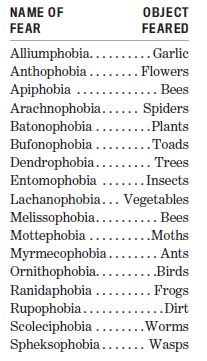IN THE GARDEN
A GARDENER'S WORST PHOBIAS

PLANTS FOR LAWNS
Choose varieties that suit your soil and your climate. All of these can withstand mowing and considerable foot traffic.
Ajuga or bugleweed (Ajuga reptans)
Corsican mint (Mentha requienii)
Dwarf cinquefoil (Potentilla tabernaemontani)
English pennyroyal (Mentha pulegium)
Green Irish moss (Sagina subulata)
Pearly everlasting (Anaphalis margaritacea)
Roman chamomile (Chamaemelum nobile)
Rupturewort (Herniaria glabra)
Speedwell (Veronica officinalis)
Stonecrop (Sedum ternatum)
Sweet violets (Viola odorata or V. tricolor)
Thyme (Thymus serpyllum)
White clover (Trifolium repens)
Wild strawberries (Fragaria virginiana)
Wintergreen or partridgeberry (Mitchella repens)
Lawn-Growing Tips
• Test your soil: The pH balance should be 7.0 or more; 6.2 to 6.7 puts your lawn at risk for fungal diseases. If the pH is too low, correct it with liming, best done in the fall.
• The best time to apply fertilizer is just before it rains.
• If you put lime and fertilizer on your lawn, spread half of it as you walk north to south, the other half as you walk east to west to cut down on missed areas.
• Any feeding of lawns in the fall should be done with a low-nitrogen, slow-acting fertilizer.
• In areas of your lawn where tree roots compete with the grass, apply some extra fertilizer to benefit both.
• Moss and sorrel in lawns usually
• Control weeds by promoting healthy lawn growth with natural fertilizers in spring and early fall.
• Raise the level of your lawn-mower blades during the hot summer days. Taller grass resists drought better than short.
• You can reduce mowing time by redesigning your lawn, reducing sharp corners and adding sweeping curves.
• During a drought, let the grass grow longer between mowings and reduce fertilizer.
• Water your lawn early in the morning or in the evening.